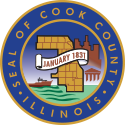Clerk David Orr Releases 2011 Tax Rates
Cook County Clerk David Orr’s office on Tuesday released the 2011 property tax rates for more than 1,500 taxing agencies* in Chicago and suburban Cook County.
This completes a process that started last December when each local taxing district, as required by law, filed its levy with the Clerk’s office. Each levy represents the amount of revenue an individual taxing body has requested to collect from the property tax.
“The Clerk’s office receives the levies, which are the amount of tax money requested by each jurisdiction, and calculates the tax rates based on state law,” said Bill Vaselopulos, manager of the Clerk’s Tax Extension Department.
Tax rates are calculated by using the amount of dollars levied by the taxing agency and the value of all taxable property located within its boundaries.
Under the Property Tax Extension Limitation Law, each Cook County taxing body with a statutory ceiling has its levy adjusted to the maximum amount based on the statutory ceiling for the district and the previous year’s total equalized assessed value (EAV) of property plus the value of any new construction, or the current year EAV―whichever is less.
This calculation can restrict the agency from receiving the full amount of its levy. Statutory rate limits apply to most categories of taxing agencies, but not to home rule units such as the City of Chicago and the County of Cook.
In accordance with the tax cap requirements of the Property Tax Extension Limitation Law, the revenue that agencies may collect is further limited, in most cases, to a 1.5 percent increase over the prior year’s extension. Home rule agencies are exempt from this limitation. Next year, tax revenues will be limited to 3.0 percent more than the amount extended this year based on the Consumer Price Index released in January, 2012.
According to Vaselopulos, the equalization factor issued by the Illinois Department of Revenue decreased this year to 2.9706, down 9.98 percent from 3.3000 last year. The Department calculates the factor needed to bring the total assessed value of all properties to a level equal to 33⅓ percent of the market value of all Cook County real estate.
For the vast majority of taxpayers, the 2011 taxable value of their property, or EAV, will be lower than the 2010 EAV. This is due, in large part, to the equalization factor being reduced by 10% this year. For areas in the county that were not reassessed (the City of Chicago and north and northwest suburbs) the EAV may have decreased between 9% to 12%. In the western and southern areas of the county that were reassessed, the EAV may have decreased between 14% to 20%, with the exception of Cicero Township which went down 26%. The reasons for the larger decreases in the reassessed townships are assessment reductions, in addition to the lower multiplier. These percentages reflect township-wide reductions. Individual taxing districts’ EAV decreases may vary.
The effect of reduced EAV’s results in higher tax rates for the vast majority of taxing districts. But this does not necessarily mean higher tax bills and more money for taxing districts. Districts continue to be limited by the CPI increase under the tax cap law.
Homeowners are again entitled to take advantage of the Alternative Homestead Exemption, commonly known as the “7 percent assessment cap”. The exemption, first enacted in 2004, phases in a 7 percent increase of a property’s taxable value each year, subject to maximums which have varied under different versions of the program.
In 2010 the program was extended for a full three-year reassessment cycle, phasing in across the county, with maximum exemptions declining from $20,000 to $16,000 and then to $12,000. The City of Chicago enters its third and final year under the extended cap, with Chicago homeowners eligible for a reduced maximum exemption of $12,000 this year, down from $16,000. Residents of north suburban Cook, in their second year under the extended cap, are able to receive an exemption maximum of $16,000 this year, down from $20,000. South suburban Cook residents, in their first year under the extended cap, are able to again receive an exemption maximum of $20,000, holding steady the amount permitted last year―their final one under the provision as enacted in 2007. The minimum exemption for all Cook County homeowners is $6,000, Vaselopulos said.
Vaselopulos added that some homeowners continue to be eligible for a Long-Time Homeowner Exemption that can provide additional relief to income-eligible homeowners who have lived in their homes at least 10 years, or five years if the home was purchased under certain assistance programs. Under the program, qualifying taxpayers are not restricted to the maximum exemption amounts that would otherwise apply but would get varying benefits based on their qualifying income.
The Senior Citizen Exemption entitles qualifying residents to an additional $4,000 exemption. Seniors are required to reapply annually for the exemption in order to continue their eligibility. Prior to 2011, the Senior Citizen Exemption was renewed automatically.
A sample of how to calculate a tax bill is attached. The impact of suburban tax rates can be figured by substituting the sample suburban rate with actual suburban rates. To download the 2011 Cook County tax rates and to view reports showing levy and valuation detail by taxing district visit www.cookcountyclerk.com.
* A taxing agency or district is a body of government such as a school district, library, municipality, etc, which levies real estate taxes.
